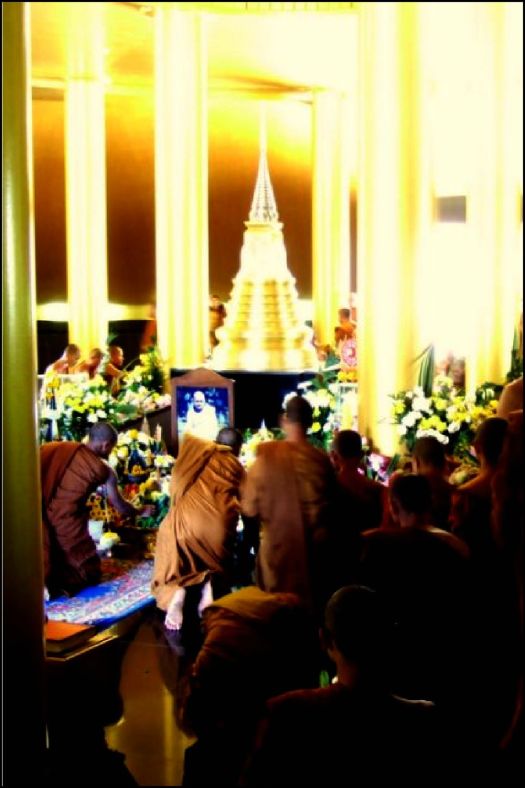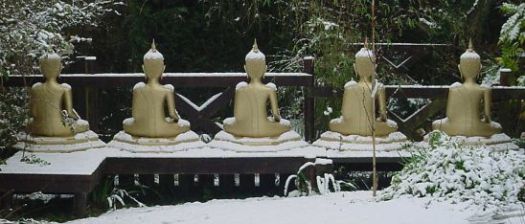.What kind of enlightenment would you like, Sir?
Several years ago I was told about a certain blog post of a fairly prominent English Buddhist teacher and author. In this particular piece he related how he had been sifting through the Pali Canon when he discovered something about the state of an arahant (an enlightened being): they don’t grieve. “Ooh,” he thought. “I don’t want that kind of enlightenment.”
The above statement comes from somebody who’s grasp of the Dhamma is seriously lacking. What kind of enlightenment does he want? Enlightenment with a sprinkling of grief? How about a squeeze of pain and despair for good measure? Surely you wouldn’t even consider having an enlightenment without some pain and despair?
It’s not as if just when you’re about to attain enlightenment you go and take your seat in a restaurant and have a waiter hand you the enlightenment menu. “Now, Sir, what kind of enlightenment will you be having?” “Well, there’s so much to choose from… Let me see…. There’s enlightenment with a side serving of pain. There’s enlightenment with grief. There’s enlightenment with despair. And then there’s the full works: enlightenment with good old birth, aging, sickness and death. I think I’ll have enlightenment with grief.” “Very good, Sir. Enlightenment with grief it is.”
What is the purpose of Buddhism? To be free from dukkha. What is dukkha? Well, to find this out we can refer to the Buddha’s stock definition of dukkha:
“This is the Noble Truth of Dukkha: birth is dukkha, aging is dukkha, sickness is dukkha, death is dukkha, sorrow, lamentation, pain, grief and despair are dukkha. Association with the loathed is dukkha. Dissociation from the pleasant is dukkha. Not to get what one wants is dukkha. In short, the five aggregates affected by clinging are dukkha.”
What is the Buddha describing here? Life! That life is, by its very nature, bound up with suffering. The purpose of Buddhism is to be free from these things; to abide in a state that is beyond these experiences, where these experiences do not occur. That, of course, is the peace and freedom of Nibbana. Sounds good, doesn’t it? Better than all this birth, aging, death and grief business. No?
So the teachings of the Buddha are very clear. They start with the Four Noble Truths: suffering, its cause, its cessation, and path. And from there the various more refined expressions of the truths open out. The Dhamma serves as a clear guide to a specific goal. If someone wants enlightenment with grief that’s easily found. All they need to do is stop practising.
Which brings us to the main point here: the need to study the Dhamma. To know what the Buddha taught. It sounds stupid, doesn’t it. If someone says they’re a Buddhist then presumably they know what the Buddha taught. Well, as the above case of a published Buddhist author shows, this ain’t necessarily the case. To learn the Dhamma we don’t need to study the whole Pali Canon: too much studying is a hindrance. In the Forest Tradition we say ‘study a little, practise a lot, realise everything’. But that little bit of studying is vital. Without it, we are like someone climbing Everest without a compass or a map.
The Recipe
We could say that following the Dhamma is like baking a cake. If we are to bake a delicious cake then we must follow the instructions carefully and closely. If we don’t, then all sorts of things can go wrong: if we forget the yeast then it won’t rise; forget the sugar (perish the thought!) and it won’t be sweet; forget to oil the tray and it’ll get stuck; add too much salt and it’ll be inedible, etc. etc.
Practising the Dhamma is the same. We need to read the instructions, get to know the recipe, and then follow it carefully. If we don’t then the cake won’t rise.
It goes without saying that we should know the Four Noble Truths off by heart. The same can be said for the Noble Eightfold Path: Right View, Right Intention, Right Speech, Right Action, Right Livelihood, Right Effort, Right Mindfulness and Right Concentration. And we should be familiar with the threefold division of the Path: morality, meditation, and wisdom. Looking further into the Buddha’s teachings we will find that he defined each of the parts of the Path in short, concise and easy to remember terms. I won’t list them now, but it would be sensible for people to know them.
Then we have the all important teaching on Kamma. To say that this is key teaching of Buddhism is a monumental understatement. And yet so many supposed Buddhists do not know what it is. Confused ideas surrounding this really quite logical, sensible and direct teaching abound. Many people equate it to fate. Others refer to it simply as the law of cause and effect. The first is wrong, the second is misleading. Of course Kamma is an expression of the law of cause and effect, but it is also much more than that: ‘kamma means ‘action’, correctly speaking it denotes the wholesome and unwholesome intentions and their associated mental factors, causing rebirth and shaping the destiny of beings’. (Definition adapted from Nyanatiloka’s Buddhist Dictionary. Now there’s a book!).
The Three Characteristics, too, are unique teachings of the Buddha that we should learn and cherish. The third of these perhaps requiring the most attention (and protection): anatta – the teaching that there is no permanent soul of self, or any abiding entity in anything.
And Nibbana. Often, and understandably, we shy away from defining it. After all, what could we possible know about it? But the Buddha spoke of it in quite concrete and concise terms that we can remember and bring up if we are asked about it. Nibbana is freedom from craving. Nibbana is freedom from greed, hatred and delusion. Nibbana is liberation from the five khandhas. Nibbana is freedom from dukkha.
Crucially, we should know what Nibbana is not. It is not eternal (eternity being in the realm of time; Nibbana is beyond time). It is not a physical place. It is not a fairy tale land of enlightened beings and their castles. ‘Sheeesh’, you may say, ‘as if I’d think that!’ Well, I heard of one highly respected teacher in the East who taught that when an enlightened being dies he or she goes to Nibbana. And there they live in a castle (in the clouds, presumably), and the size of that castle depends on their accumulated paramis (perfections); those with the most paramis having the biggest castles… (I wonder if you get double glazing if your paramis are really strong…) Perhaps this view could have been avoided if he’d have learnt some basic Dhamma.
So where do we look to study the teachings of the Buddha? Usually in books. But there are sooo many books on Buddhism. And unfortunately 99.9% of them tell you more about the author than the Dhamma. And many are as stuffed with errors as a .
One day, when I was a lay-man, I trundled into Waterstones book shop, headed to the appropriate sections, grabbed about six Buddhisty books, did the business at the till, and walked out. Five of those books I would not now recommend. That leaves one that was good. That book was ‘What the Buddha Taught’, by Walpola Rahula. It was a revelation. It’s one of those books that, when reading, you frequently pause after a sentence, look up from the page, close your eyes, breathe in deeply, and saviour the shift in the depths of your mind. Then you read on for more. This book stands head and shoulders above the majority of Buddhist books as a pure expression of the Dhamma, simply because it stays so close to the Dhamma, with little or no interference from the author’s opinions. It is a reasonably short, concise, but also thorough exposition of the key teachings of the Buddha, laden with quotes to boot. And it is well written. To read a book such as this is highly advisable.
Then, of course, there is the Pali Canon – the oldest record of what the Buddha actually taught. This requires some care when approaching as its sheer volume can be daunting. But there are anthologies – very good ones – that aim to guide readers by the hand into this rare and precious world of the Buddha’s actual words. As a starter, Bhikkhu Bodhi’s anthology ‘In the Buddha’s Words’ is ideal, as is an ‘Anthology of the Anguttara Nikaya’.
The Raft
The Buddha famously likened the Dhamma to a raft that, once it has carried us to the further shore of Nibbana, should be discarded. But until that point the raft of the Dhamma must be learnt, remembered, investigated, and practised.
.
And with the Blessed One’s attainment of final Nibbana, some bhikkhus who were not without [passion] stretched out there arms and wept, and they fell down and rolled back and forth: “So soon has the Blessed One attained Final Nibbana! So soon the Sublime One attained Final Nibbana! So soon the Eye has vanished from the world!” But those who were free from [passion], mindful and fully aware, said: “Formations are impermanent. How could it be that what is born, come to being, formed and bound to fall should not fall? That is not possible.”
Then the [arahant] Venerable Anuruddha addressed the bhikkhus: “Enough, friends, do not sorrow, do not lament. Has it not already been declared by the Blessed One that there is separation and parting and division from all that is dear and beloved? How could it be that what is born, come to being, formed and bound to fall should not fall? That is not possible.” (D. 16*)
.
Several years ago someone told me about a certain blog post written by a fairly prominent English Buddhist teacher and author. In this particular piece he related how he had been sifting through the Pali Canon when he discovered something about the state of an arahant (an enlightened being): they don’t grieve.
“Oh,” he thought. “I don’t want that kind of enlightenment.”
The above statement comes from somebody whose grasp of the Dhamma is seriously weak. What kind of enlightenment does he want? Enlightenment with a sprinkling of grief? How about a squeeze of pain and despair for good measure? Surely you wouldn’t want enlightenment without some mental pain and despair?
It’s not as if just when you’re about to attain enlightenment you go and take your seat in a restaurant and have a waiter hand you the enlightenment menu. “Now, Sir, what kind of enlightenment will you be having?” “Well, gosh. There’s so much to choose from… Let me see…. There’s enlightenment with a side serving of pain. There’s enlightenment with grief. There’s enlightenment with despair. And then there’s the full works: enlightenment à la birth, aging, sickness and death. I think I’ll have enlightenment with grief.” “Very good, Sir. Enlightenment with grief it is.”
What is the purpose of Buddhism? To be free from dukkha. What is dukkha? To find this out we can refer to the Buddha’s stock definition of dukkha:
“This is the Noble Truth of Dukkha: birth is dukkha, ageing is dukkha, sickness is dukkha, death is dukkha, sorrow, lamentation, pain, grief and despair are dukkha. Association with the loathed is dukkha; dissociation from the pleasant is dukkha. Not to get what one wants is dukkha. In short, the five aggregates affected by clinging are dukkha.”
What is the Buddha describing here? Life! That life is, by its very nature, bound up with suffering. The purpose of Buddhism is to be free from dukkha; to abide in a state of perfect wisdom that is beyond these experiences, where these experiences do not occur. That, of course, is the peace and freedom of Nibbana. Sounds good, doesn’t it? Better than all this birth, death and grief business. No?
So the teachings of the Buddha are very clear. They start with the Four Noble Truths: suffering, its cause, its cessation, and the Path. And from there the various more refined expressions of the Truths open out. The Dhamma serves as a clear guide to a specific goal.
Which brings us to the main point here: the need to study the Dhamma; to know what the Buddha taught. For the practice of Buddhism to lead us to the goal it must be supported by, as Bhikkhu Bodhi says, ‘a clear understanding of the basic principles of the teaching’. To learn the Dhamma we don’t need to study the whole Pali Canon though; too much reading and our minds will be so full of words it will be difficult to meditate. In the Forest Tradition we say ‘study a little, practise a lot, realise everything’. But that little bit of studying goes a very long way. Without it, we are like someone climbing Everest without a compass or a map.
The Recipe
As well as a compass and a map, we could say that following the Dhamma is like following a recipe. If we are to bake a delicious cake then we must follow the instructions carefully and closely. If we don’t, then all sorts of things can go wrong: if we forget the yeast then it won’t rise; forget the sugar and it won’t be sweet; forget to oil the tray and it’ll get stuck; add too much salt and it’ll be inedible, etc. etc.
Practising the Dhamma is the same. We need to read the instructions, get to know the recipe, and then follow it carefully. If we don’t then the cake won’t rise.
It goes without saying that we should know the Four Noble Truths off by heart. The same can be said for the Noble Eightfold Path: Right View, Right Intention, Right Speech, Right Action, Right Livelihood, Right Effort, Right Mindfulness and Right Concentration. And we should be familiar with the threefold division of the Path: morality, meditation, and wisdom. Looking further into the Buddha’s teachings we will find that he defined each of the parts of the Path in short, concise and easy to remember terms. I won’t list them now, but it would be sensible for people to know them.
The teaching on Kamma should also be studied. Many people have confused ideas about this quite logical, sensible and direct teaching. Some equate it with fate. Others refer to it simply as the law of cause and effect. The first is wrong, the second is misleading. Of course Kamma is an expression of the law of cause and effect, but it is also much more than that: The term kamma literally means ‘action’. But more importantly it means ‘intentional action’. “Intention is Kamma”, said the Buddha. “Having willed, one acts by way of body, speech and mind.” (AN 6.63). It is these intentional actions that shape our future and lead to rebirth.
The Three Characteristics, too, are unique teachings of the Buddha that we should learn and cherish. The third of these perhaps requires the most attention (and protection): anatta – the teaching that there is no permanent soul of self, or any abiding entity in anything.
And Nibbana. Often, and understandably, we shy away from defining it. After all, what could we possibly know about it? But the Buddha spoke of it in quite concrete and concise terms that we can remember and bring up if we are asked about it. Nibbana is freedom from craving. Nibbana is freedom from greed, hatred and delusion. Nibbana is liberation from the five aggregates. Nibbana is freedom from dukkha.
Crucially, we should know what Nibbana is not. Nibbana cannot be said to be eternal: eternity being in the realm of time; Nibbana is beyond time. Nor is it annihilation. It is not a physical place. It is certainly not a fairy tale land of enlightened beings and their castles… (I once heard of a highly respected teacher in the East who taught that when an enlightened being dies he or she goes to Nibbana. And there they live in a castle. And the size of that castle depends on their accumulated paramis (perfections); those with the most paramis having the biggest castles… (I wonder if you get double glazing if your paramis are really strong!) This view could have been avoided if he’d have learnt some basic Dhamma.)
The above list has by no means exhausted what is to be learnt, but it’s a start.
Books
So where do we look to study the teachings of the Buddha? Usually in books. But there are sooo many books on Buddhism. And unfortunately 99.9% of them tell you more about the author than the Dhamma. And not a few are as stuffed with errors as a bean-bag is with beans.
And then there’s the double-edged sword that is the Internet. I read a quote by the philosopher AC Grayling the other day:
“The democracy of blogging and tweeting is absolutely terrific in one way. It is also the most effective producer of rubbish and insult and falsehood we have yet invented.”
This can be extended to the web in general: there’s certainly no shortage of rubbish and insult and falsehood written about Buddhism in the great ether. Therefore one must be very selective. A newcomer trawling the web for information on Buddhism can be likened to someone reaching blindly down into a barrel of water teeming with piranhas but containing only a few pearls.
Good books are hard to come by
One day, when I was a lay-man, I strolled into a flashy Waterstone’s book shop, headed to the appropriate sections, grabbed about six colourful Buddhistish books, did the business at the till, and sauntered out. Four of those books I would not now recommend. That leaves one that was all right and one that was very good. The latter was ‘What the Buddha Taught‘, by Walpola Rahula.
It was a revelation. It’s one of those books that, when reading, you frequently pause after a sentence, lift your head from the page, slowly close your eyes, breathe in deeply, and savour the moment as a piece of the jigsaw sinks into place. Then you open your eyes again, pause, and lower your head for more. Leaving the scriptures aside, this book sets the benchmark as a relatively pure expression of the Dhamma, simply because it stays so close to the scriptures, with little or no interference from the author’s opinions. It is a reasonably short, concise, but also thorough exposition of the essential teachings of the Buddha, laden with quotes to boot. And it is well written. To read a book such as this is highly advisable.
However, if we really want to know what the Buddha taught then there’s only one place to look: the Tipitika – the Pali Canon (and also the Mahayana equivalent) – the oldest record of the Buddha’s actual words (Buddhavacana). Reading books about Buddhism, as opposed to the Buddhavacana, is similar to riding a bike with stabilisers. At first, it might be sensible; we become accustomed to the act of riding. But pretty soon those stabilisers are going to be a hindrance and so they have to go. Then we can experience the act of riding in its pure form. So too, once we have a reasonable grasp of the Dhamma through reading about Buddhism we shouldn’t hesitate to plunge into the vast treasure trove of the Canon. (This isn’t, of course, to say that we shouldn’t read the suttas right from the beginning of our practice; it’s just that if we have only read books about Buddhism, then we will need to look at moving on to the Canonical works.)
As a starter, Bhikkhu Bodhi’s anthology ‘In the Buddha’s Words’ is an ideal guide to lead its reader by the hand into this sublime world of the Buddha’s words. Nyanatiloka’s and Bhikkhu Bodhi’s anthology ‘Numerical Discourses of the Buddha‘ in some respects is even more approachable. It is not set out in such a systematic way as ‘In the Buddha’s Words’, but it contains a host of brief and pithy suttas, many addressed to the Buddha’s lay-disciples. Bhikkhu Nyanamoli’s anthology ‘The Life of the Buddha‘ is one of my favourite books, largely because it reads so well. If you want to dive head first into a complete text then the Majjhima Nikaya is perhaps the best.
The Raft
The Buddha famously likened the Dhamma to a raft that – once it has carried us to the further shore of Nibbana – should be relinquished. But until we reach that point the raft of the Dhamma must be learnt, remembered, investigated, and put into practice.
.
*From Bhikkhu Nyanamoli’s ‘The Life of the Buddha’. I use ‘Passion’ instead of the original ‘lust’.
.
The next teaching will be on:
the new moon day, Thursday 20th August



 .
. .
.






